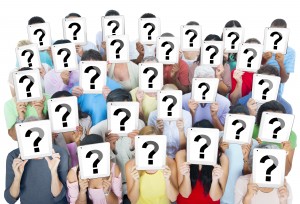
Stigma is basically a word for discrimination. Stigma has been described as a sign of disgrace that is perceived to set a person or group of people apart from others. It’s also a Greek letter, although everyone that uses it in that way is rubbish.
Stigma can affect many groups, including people with mental health problems, the elderly, and a third less serious group that I was going to include as a joke, but didn’t because it would increase stigma too much.
Perhaps unsurprisingly, people with intellectual disabilities experience plenty of this kind of discrimination. This includes hate crimes, fewer employment opportunities compared to people without intellectual disabilities, fewer opportunities to participate in community-based activities and a decreased ability to access appropriate healthcare.
While there isn’t much research regarding the impact of stigma in people with intellectual disability (a fact which in itself may be related to stigma), in people with mental illness self-stigma is associated with higher levels of psychological distress, worse adherence to treatment and decreased use of health services (if available in the first place).
Studies show that the impact of stigma isn’t just through people being offended. Stigma causes actual harm. The studies that do exist examining the impact of stigma on people with intellectual disability indicate that those who do report experiencing stigma generally have comparatively low self-esteem, fewer aspirations for the future, more problems accessing healthcare and increased probability of dying from preventable causes.
To compound the problem, people with intellectual disability may actually be more vulnerable to the psychological distress resulting from experiencing stigma. This is due to already being subject to numerous social adversities and potentially a lack of access to coping strategies and problem solving ability. Stigma is the straw that breaks the camel’s back. If the camel’s back is a person’s life, and the camel is a person with a disadvantage in society, and yes, the metaphor is an awful one.
Some researchers therefore hypothesised that self-reported stigma would be positively associated with psychological distress and negatively associated with quality of life, contact with services and adherence to treatment in people with intellectual disability. They then did some stuff and looked at what had happened using numbers to see if this was true enough. Science!

People with intellectual disabilities experience stigma and discrimination on a daily basis.
Methods
A cross section of participants with intellectual disabilities (and no mental illness) was recruited from 12 sites in England; including community intellectual disability services, day centres, social clubs, supported accommodation and voluntary organisations.
Participants were recruited through invitation letters or via professionals involved with the sites. Sadly, a successful research participants wanted Bat-signal is yet to be invented.
Inclusion criteria
Participants had to be at least 18 years old and have intellectual disability. This was defined as eligibility to receive specialist intellectual disability services. This, in turn, is based on ICD-10 (World Health Organization) or DSM-IV (American Psychiatric Association) criteria.
For a diagnosis of intellectual disability, an individual has to meet three criteria:
- Impairment in intellectual functioning (characterised by an IQ less than 70)
- Impairment in adaptive functioning (e.g. requires support in at least two aspects of daily living)
- These impairments should arise before age 18
Individuals with mild (roughly equivalent to IQ 50-69) and moderate (roughly equivalent to IQ 35-49) intellectual disability were included.
Exclusion criteria
Individuals with a current diagnosis of mental illness needing treatment were excluded. People with mental illness experience plenty of stigma, and it was important (in this study at least) to differentiate this from stigma experienced by people with intellectual disability. It’s all awful, but it might be helpful to know specifically how and why.
Individuals were also excluded if their level of comprehension or verbal skill prevented them completing the tasks necessary for participation in the study, if they were unable to speak English or if they were unable to give consent to take part in the study.

Stigma is mostly awful, but it might be helpful to know specifically how and why in people with intellectual disabilities.
Measurements
Self-reported stigma was measured using a ten item questionnaire. The questionnaire consisted of perceived discrimination and reaction to discrimination subscales. Depression and anxiety levels were measured using the 14 item version of the Clinical Outcomes in Routine Evaluation (CORE). With the CORE, a higher score means more psychological distress. Points sometimes don’t mean prizes.
Quality of life, service utilisation and adherence to treatment were also measured using questionnaires. These were administered face-to-face and with any support necessary, e.g. the help of a carer.
Results
229 participants were recruited:
- Mean age 40.9 years
- 52.4% male
- 82.1% Caucasian
- 72.7% mild intellectual disability
Self-reported stigma was positively associated with psychological distress, i.e. as self-reported stigma increased, so did psychological distress (adjusted regression coefficient 0.92, standard deviation [SD] 0.20, P<0.01). Both stigma subscales were significantly associated with psychological distress.
There was a negative association between stigma and quality of life, i.e. as stigma increased, quality of life decreased (-0.69, SD 0.20, p<0.01). Both stigma subscales were significantly negatively associated quality of life. So far, so as expected.
Stigma was positively associated with the number of contacts made with services; particularly contact with community intellectual disability services and the police. While both stigma subscales had an association with number of police contacts, only perceived discrimination was associated with contacts with community intellectual disability services. Self-reported stigma was also associated with refusal of at least one service in the last six months.
Self-reported stigma was not associated with adherence to treatment.
The relationship between stigma and quality of life and stigma and service use were mediated by psychological distress. That is to say that increased psychological distress usually also meant lower quality of life and higher number of service contacts in those with high and low levels of stigma.

Self-reported stigma was positively associated with psychological distress.
Authors’ conclusions
The authors stated that this study provides evidence that stigma may contribute to poor psychological health in people with intellectual disability by increasing psychological distress and reducing quality of life.
They also argued that people with intellectual disabilities may be more likely than other stigmatised groups to seek professional help when experiencing stigma, possibly because of fewer support networks. They also noted that conversely, higher levels of stigma were also associated with refusal of at least one service in the previous six months. As such, individuals may be seeking help and then refusing it, possibly because they do not consider the help being offered to be appropriate to their needs. So help has to be there, has to be worthwhile, and has to be considered worthwhile by the people being offered it. This could be considered the “fire triangle” of help. Help being there can be “heat” if you like.
The authors finish by arguing that the first priority for intervention should be to reduce stigma associated with intellectual disability with public information campaigns, training of health and social care professionals, and ensuring people with intellectual disabilities are able to fully integrate with their communities. This is pretty much always the priority for stigma interventions, although finding good evidence for it is difficult. As such, they authors don’t say how to accomplish this. They can’t. This isn’t their fault. Interventions are also needed to help reduce the psychological distress associated with stigma. Although you could argue that psychological distress is a natural reaction to stigma. Stigma is bad.

There is an urgent need to develop evidence-based interventions to reduce societal stigma against people with intellectual disabilities.
Limitations
The authors noted that the cross-sectional design doesn’t allow them to make any claims about causality when it comes to stigma, distress, quality of life and use of services. For example, people who use services may be more psychologically distressed compared with people who use fewer services. That’s arguably part of the function of these services. They also argued that it’s possible that services and professionals are themselves contributing to the stigma. In fact, several studies suggest that health professionals may hold discriminatory attitudes towards people with intellectual disability e.g. negative attitudes and failing to make appropriate adjustments. Needless to say, it doesn’t reduce stigma and distress if the place you go to for help provides more stigma and distress.
The authors also noted that IQ (one of the important criteria for defining the population they were trying to sample) was not formally assessed but was based on clinical data. Essentially they had to trust that the notes they were reading were correct. Luckily, notes are always correct. ALWAYS!
It’s obvious from the demographic data that the majority of people who took part in the study had mild intellectual disability as opposed to moderate. This research is therefore only representative of stigma in this population setting. It is not known how the “level of intellectual disability” will affect the extent of perceived stigma or how this impacts psychological distress and quality of life, nor can it be known without specifically looking at this population. Having said that, perhaps it’s enough to see that there is a stigma associated with having intellectual disability, that this negatively affects peoples’ lives, and that something should be done to reduce it. Perhaps.
Finally, and perhaps predictably, a limitation may be related to the terminology “intellectual disability” itself. This is the technical term and it’s used throughout this post as a result of it being used in the paper that this post is about. But does talking about “disability” and defining someone using something they can’t do, actually increase the stigma that the study is trying to investigate and ultimately prevent? It’s difficult to say without more evidence; although if it is the case, it’s not a particularly enjoyable irony.

People who use services may be more psychologically distressed compared with people who use fewer services.
Summary
This cross sectional study demonstrated that in people with (predominantly mild) intellectual disability, increased stigma is associated with:
- Increased psychological distress
- Reduced quality of life
- Increased contact with services
It cannot say what causes what, but a two-way relationship seems likely.
Interventions are needed to reduce this stigma in the community and in the health service. Interventions are always needed. Although there isn’t much evidence to say which ones. Even the term used to “define” the population of people that stigma may be a problem for could be increasing stigma.
It seems there’s a long way to go before this stops being a problem, but perhaps in drawing attention to some of the issues, this study is a small starting point.
Links
Primary paper
Ali A, King M, Strydom A, Hassiotis A. (2015) Self-reported stigma and symptoms of anxiety and depression in people with intellectual disabilities: findings from a cross sectional study in England. Journal of Affective Disorders 2015;187: 224–231. doi:10.1016/j.jad.2015.07.046 [Abstract]
Other references
Ali A, et al. (2013) Discrimination and other barriers to accessing health care: perspectives of patients with mild and moderate intellectual disability and their carers. PLoS One. 2013;12:8(8):e70855. [PubMed]
Busby GJ, et al. (2015) Predictors of personal, perceived and self-stigma towards anxiety and depression. Epidemiol Psychiatr Sci. 2015;20:1-8. [PubMed]
Jahoda A, Markova I. (2004) Coping with social stigma: people with intellectual disabilities moving from institutions and family home. J Intellect Disabil Res. 2004;48:719-29. [PubMed]
Pederson ER, Paves AP. (2014) Comparing perceived public stigma and personal stigma of mental health treatment seeking in a young adult sample. Psychiatry Res. 2014;219(1):143-50. [PubMed]

Stigma increases psychological distress in people with intellectual disabilities https://t.co/dvIW4Th8bZ By me. For @LearningDisElf
.@hullodave on study of self-reported stigma & symptoms of anxiety & depression in ppl w intellectual disabilities https://t.co/m2xGOVMCop
Morning @likahassiotis We’ve blogged about your recent #stigma study https://t.co/m2xGOVMCop Please let us know what you think
@LearningDisElf I love it and it’s great you’re blogging on our work!
Needed: A BAT signal for research participants! *EXCELLENT idea, whose got ideas?? @SpeechDudes @BronwynHemsley – https://t.co/e5etKvfirk
Stigma, intellectual disabilities and psychological distress https://t.co/pUmvatcyyG
Stigma increases distress in people with intellectual disabilities. Stop doing it! https://t.co/dvIW4Th8bZ By me. For @LearningDisElf
Research highlights urgent need to develop evidence-based interventions to reduce societal stigma against PWLD https://t.co/m2xGOVMCop
Stigma increases psychological distress in pwld https://t.co/nOfGbaFDXE @@GCUvalues @@GCUNursing @Theresa_ENABLE@@GCUMentalHealth
Stigma increases distress in people with intellectual disabilities. https://t.co/dvIW4Th8bZ By me. For @LearningDisElf. Features Bat-signal.
PWLD who use services may be more psychologically distressed compared with people who use fewer services https://t.co/m2xGOVMCop
RT @hullodave: Basically, don’t discriminate against people with intellectual disabilities. https://t.co/dvIW4Th8bZ Some stuff by me. For @…
Study of ppl w intellectual disabilities finds self-reported stigma positively assoc w psychological distress https://t.co/m2xGOVMCop
Stigma, intellectual disabilities and psychological distress https://t.co/wTZUoyHr6C
Don’t miss: Stigma increases psychological distress in people with intellectual disabilities https://t.co/m2xGOVMCop #EBP
Stigma increases distress in people with intellectual disabilities. https://t.co/dvIW4Th8bZ Wrote a thing for @LearningDisElf
Stigma increases psychological distress in people with intellectual disabilities. https://t.co/dvIW4Th8bZ
Stigma, intellectual disabilities and psychological distress – The Learning Disability Elf https://t.co/WTI5UCgviB
Stigma increases psychological distress for people with intellectual disability from @NatElfService https://t.co/Kv18jnf9bg
“Stigma increases psychological distress in people with intellectual disabilities” https://t.co/haAZHyFxnx via @LearningDisElf
[…] 1Stigma, intellectual disabilities and psychological distress: The Learning Disabilities Elf […]